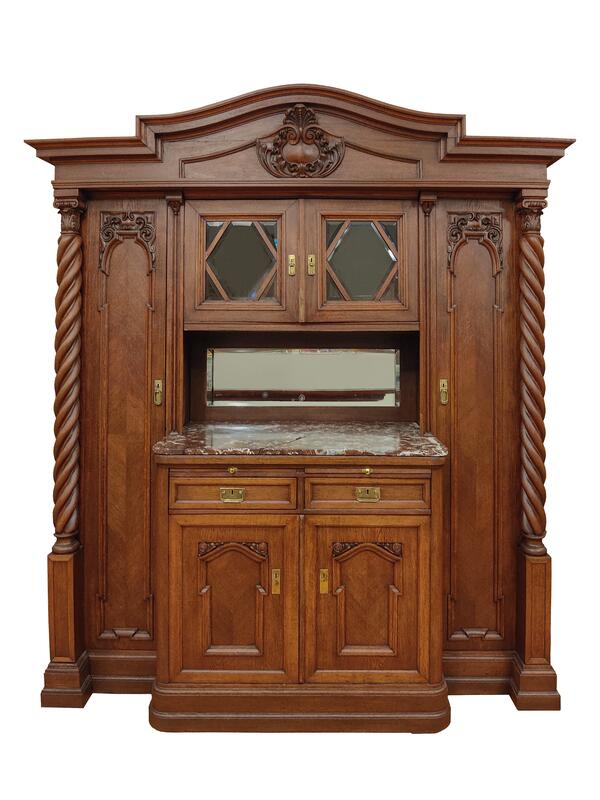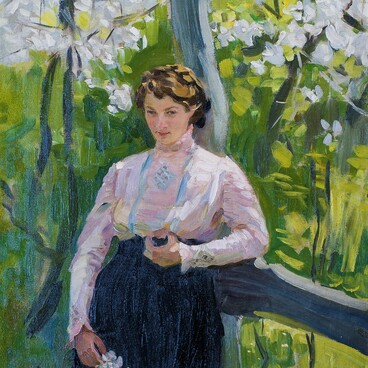The massive buffet displayed at the museum was intended for the spacious dining room of a large merchant’s house. It was purchased from the descendants of the Murom family of merchants Bondyrevs, whose surname was eventually transformed into the Bondarevs.
The buffet was made of oak, the edges are decorated with woven columns. In the upper part of the buffet, there are small glass windows. Their edges are made faceted — that is cut at an angle, like mirrors. The top of the buffet is decorated with a carved cornice.
In the center of the buffet, there is a solid marble board tabletop and a wooden pull-out tabletop. Sliding tabletops were a characteristic device in buffets — as a rule, they were used to cut bread and various appetizers before serving them on the table or to arrange vases with treats. Marble tabletops were rare; they could be seen only in rich merchant houses.
The first buffets date back to the Middle Ages. Their mandatory elements were shelves and doors. They became more similar to modern models in the 16th century.
In the 17th century, the first corner buffets were made in one or two levels. On the shelves the owners usually arranged silverware and porcelain dishes, which were considered objects of pride and wealth in the family. Around this time, buffets also had drawers, which over time were equipped with locks and locking mechanisms. They were used to store serving utensils and table linen.
A table with a spacious niche was placed between the upper and lower sections of such furniture, just as in the buffet from the museum’s collection. In different countries, these niches were used to store vases of fruit, wine bottles or beer mugs, decorative objects or souvenirs.
The lower part of the buffet, the cabinets, were used to store large objects and large dinner, tea or coffee sets. Unused food in closed containers was also placed there. This space was usually covered by two blank, i. e. non-transparent, doors.
Particular attention was paid to the decoration of buffets. They were made of strong and durable wood: walnut, oak, mahogany and others. Masters carved relief images in wood: everyday scenes, biblical plots, floral drawings. Some elements were decorated with geometric and floral ornaments. Wooden plates or inlays were also used as decorations. Buffets could rich the floor or put on carved legs of various forms.
The buffet was made of oak, the edges are decorated with woven columns. In the upper part of the buffet, there are small glass windows. Their edges are made faceted — that is cut at an angle, like mirrors. The top of the buffet is decorated with a carved cornice.
In the center of the buffet, there is a solid marble board tabletop and a wooden pull-out tabletop. Sliding tabletops were a characteristic device in buffets — as a rule, they were used to cut bread and various appetizers before serving them on the table or to arrange vases with treats. Marble tabletops were rare; they could be seen only in rich merchant houses.
The first buffets date back to the Middle Ages. Their mandatory elements were shelves and doors. They became more similar to modern models in the 16th century.
In the 17th century, the first corner buffets were made in one or two levels. On the shelves the owners usually arranged silverware and porcelain dishes, which were considered objects of pride and wealth in the family. Around this time, buffets also had drawers, which over time were equipped with locks and locking mechanisms. They were used to store serving utensils and table linen.
A table with a spacious niche was placed between the upper and lower sections of such furniture, just as in the buffet from the museum’s collection. In different countries, these niches were used to store vases of fruit, wine bottles or beer mugs, decorative objects or souvenirs.
The lower part of the buffet, the cabinets, were used to store large objects and large dinner, tea or coffee sets. Unused food in closed containers was also placed there. This space was usually covered by two blank, i. e. non-transparent, doors.
Particular attention was paid to the decoration of buffets. They were made of strong and durable wood: walnut, oak, mahogany and others. Masters carved relief images in wood: everyday scenes, biblical plots, floral drawings. Some elements were decorated with geometric and floral ornaments. Wooden plates or inlays were also used as decorations. Buffets could rich the floor or put on carved legs of various forms.



